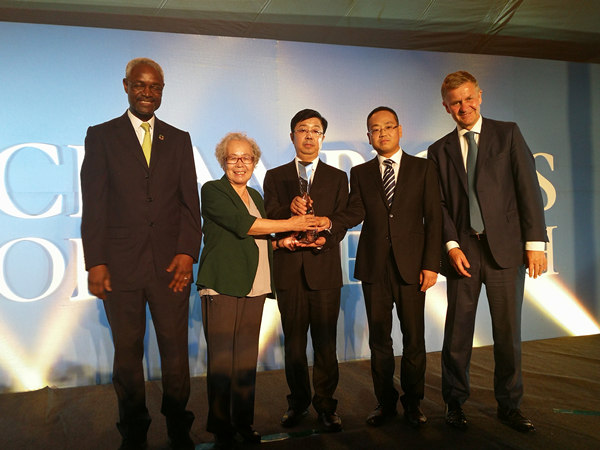


There are 350 million smokers in China. Half of them will die because of smoking-related diseases, and non-smokers affected by secondary smoking exceed 500 million.
The figures come from a report conducted by the Ministry of Health last year, which also shows half of the smokers "want to quit" and 17 percent "urgently" want to get rid of the bad habit.
"Along with the living standards increasing and increased health awareness, anti-smoking demands will further increase," says Zhang Yifang, vice chairman with non-profit organization Chinese Association on Tobacco Control.
Savvy pharmaceutical businesses can cash in on the promising no-smoking market just like US-based pharmaceutical giant Pfizer has begun to try to do with Champix, a smoking cessation medicine. Champix was introduced to the Chinese market in early December.
According to Jotham Coe, a medicinal chemist in the Neuroscience Department of Pfizer Global Research and Development and also a Champix researcher, the medicine is designed to help make it easier for smokers go through the transition from lighting up to being an ex-smoker.
He explains the mechanism of Champix: the lung's job of delivering oxygen to brain and rest of the body is very efficient, when a smoker has a cigarette, nicotine can also be very efficiently transferred to the brain, releasing dopamine, a brain chemical that stimulates people.
"Champix can keep the dopamine at a mid-level, helping smokers to not feel bad and then kick their dependence on nicotine," says Coe, adding that on the other hand, if ex-smokers relapse while on Champix, they will not feel as stimulated as before.
Nicotine is called an agonist, Champix is a partial agonist, but it's not addictive like nicotine, says Coe.
Competition
Other foreign pharmaceutical manufacturers are also eyeing the Chinese smoking cessation market.
Last September, Sweden-headquartered Novartis introduced anti-smoking patch Nicotinell into the emerging market. Nicotinell is also listed on the first group of smoking cessation pharmaceuticals recommended by World Health Organization.
Compared with Champix launched in 2006, Nicotinell has been selling in developed marketplaces for over 10 years and its global sales reached $700 million. The company said in a China market launch ceremony of Nicotinell that sales of the patch in China are expected to be between 10 and 20 million yuan in 2008.
Some Chinese-language newspapers have reported that Johnson & Johnson will also promote a smoking cessation gum in China but it hasn't appeared as yet.
Both of the above, different from Champix, are classified as nicotine-replacement therapy by the medical sector.
Over the recent years, some domestic companies developed stop-smoking aids using traditional Chinese medicine, acupuncture and massage that they claim will end nicotine addiction, but none of them have been popular with mainland consumers.
Consumer market
Champix's Coe says that the cost of Champix will be similar to the cost of cigarettes and the recommended treatment period is three months, but it also depends on a doctor's recommendation and the individual conditions of the smoker.
"In my view, because within usually seven days you quit smoking, you begin to save money in the second week. It's very cost-effective," says Coe.
Norvatis's Nicotinell patches should be worn everyday for three months. The retail price for 30-patch package is about 500 yuan.
Prices of domestic stop smoking aids are not cheap. Take Ruyan as an example. According to the company, its electronic cigarettes, cigars and pipes with their replaceable cartridges provide the pleasure of smoking without the danger.
Ruyan pipe series are tagged at 800 yuan to 5,000 yuan, and the one-time replaceable cartridges are priced between 10 to 30 yuan each.
An ex-smoker Jin Jingyang says he doesn't believe in any medicine and therapy at all. The 56-year-old Beijinger quit smoking at the age of 46, when he was diagnosed hypertension, coronary heart disease and bronchitis.
"It was really a difficult time," he says. Jin says he constantly felt depressed, impatient, and irritable at the beginning and tried many methods, including the patch as well as traditional Chinese medicine.
He quit and relapsed and then quit and relapsed, until one morning, when he woke up and wanted to smoke a cigarette in bed when his wife said: "I am totally disappointed in you."
"That sentence made me really clearheaded. I told myself I must act as a man and keep to my commitment to win back her respect and love," recalls Jin, who hasn't had a cigarette since that day.
"I feel good now and the diseases went away, I believe in my own willpower," says Jin with proud smile.
Champix's developer Coe, around 50, is also an ex-smoker, who quit smoking at 30. He himself has experienced hypnotherapy, but no effect and used nicotine-replacement gum, but unfortunately became addicted to it. At last, he won he says because of his strong commitment to not smoke.
Everyone can quit, but everyone can also easily start again, because smoking is related to friends, alcohol, stress, work, play, coffee breaks and becomes part of fabric of a smoker's life, says Coe.
"I believe most smokers want to quit, every smoker needs to learn that they do not have the power over cigarettes, unless they really commit to quitting," he says.
Champix made the transition from a smoker to an ex-smoker easier, he adds.
China's heavy smoking culture is changing slowly and it's becoming easier to promote smoking cessation products.
The Framework Convention on Tobacco Control was the first treaty negotiated under the auspices of the World Health Organization. China became the 77th contracting member of the organization in November 2003.
From then on, the central government has issued a series of policies to support smoking cessation which include increasing the cigarette tax, gradually eliminating cigarette advertisement, strengthening cracking down on cigarette smuggling, and proposals to put stark health warning slogans on cigarette pack.
"The policies promote people's awareness of smoking abatement and help create a positive environment for the anti-smoking organizations," notes Zhang of the Chinese Association on Tobacco Control.
(China Daily 12/22/2008 page7)













